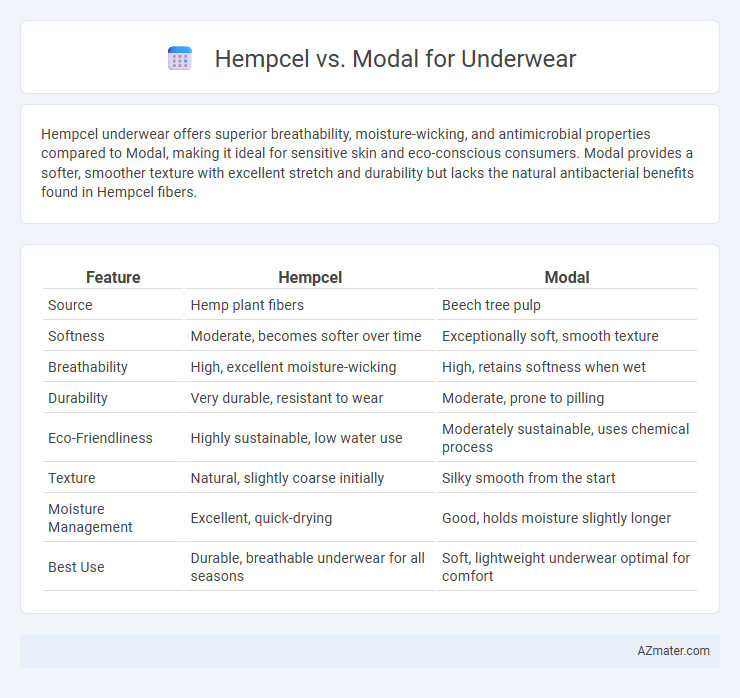Hempcel underwear offers superior breathability, moisture-wicking, and antimicrobial properties compared to Modal, making it ideal for sensitive skin and eco-conscious consumers. Modal provides a softer, smoother texture with excellent stretch and durability but lacks the natural antibacterial benefits found in Hempcel fibers.
Table of Comparison
| Feature | Hempcel | Modal |
|---|---|---|
| Source | Hemp plant fibers | Beech tree pulp |
| Softness | Moderate, becomes softer over time | Exceptionally soft, smooth texture |
| Breathability | High, excellent moisture-wicking | High, retains softness when wet |
| Durability | Very durable, resistant to wear | Moderate, prone to pilling |
| Eco-Friendliness | Highly sustainable, low water use | Moderately sustainable, uses chemical process |
| Texture | Natural, slightly coarse initially | Silky smooth from the start |
| Moisture Management | Excellent, quick-drying | Good, holds moisture slightly longer |
| Best Use | Durable, breathable underwear for all seasons | Soft, lightweight underwear optimal for comfort |
Introduction: The Rise of Sustainable Underwear Fabrics
Hempcel and Modal represent two cutting-edge sustainable fabrics revolutionizing underwear production with their eco-friendly properties and superior comfort. Hempcel boasts durability, natural antibacterial qualities, and biodegradability, making it ideal for environmentally conscious consumers seeking long-lasting underwear. Modal offers exceptional softness, moisture-wicking abilities, and breathability, providing a luxurious feel while minimizing environmental impact through its renewable beechwood source.
What is Hempcel? Key Properties and Benefits
Hempcel is a fabric derived from hemp fibers combined with cellulose to create a sustainable and breathable textile, ideal for underwear due to its natural moisture-wicking and antimicrobial properties. Its key benefits include durability, hypoallergenic qualities, and superior temperature regulation, which help maintain comfort throughout the day. Compared to Modal, Hempcel offers enhanced eco-friendliness and longer-lasting performance, making it an excellent choice for conscious consumers.
Understanding Modal: Composition and Advantages
Modal underwear is made from beech tree pulp, creating a semi-synthetic fabric known for its exceptional softness and breathability. Its moisture-wicking properties keep the skin dry, making it an ideal choice for underwear that requires comfort and durability. Modal fibers also retain shape and color longer than cotton, enhancing the garment's longevity and overall quality.
Comparing Softness and Comfort: Hempcel vs Modal
Hempcel underwear offers natural breathability and durability with a slightly firmer texture, making it ideal for those seeking eco-friendly comfort with moisture-wicking properties. Modal fabric excels in softness and smoothness, providing a silky feel against the skin that enhances all-day comfort and reduces irritation. When prioritizing softness and comfort, modal tends to outperform hempcel, although hempcel is preferred for its hypoallergenic benefits and sustainable qualities.
Breathability and Moisture-Wicking Performance
Hempcel fabric offers superior breathability due to its naturally porous fibers, which enhance airflow and keep the skin cool and dry during wear. Modal, made from beech tree pulp, excels in moisture-wicking performance by rapidly absorbing and releasing sweat, maintaining comfort in humid conditions. When comparing Hempcel and Modal for underwear, Hempcel provides better ventilation, while Modal delivers more efficient moisture management for active lifestyles.
Durability and Longevity: Which Lasts Longer?
Hempcel underwear outperforms modal in durability due to hemp fibers' natural strength and resistance to wear, making them less prone to pilling and tearing over time. Modal, derived from beech tree fibers, offers softness but tends to degrade faster with frequent washing and stretching. Choosing Hempcel ensures longer-lasting underwear that maintains integrity through extended use and multiple laundry cycles.
Eco-Friendliness: Environmental Impact of Hempcel and Modal
Hempcel underwear offers superior eco-friendliness due to its use of hemp, a fast-growing, renewable crop requiring minimal water and pesticides, which significantly reduces its environmental footprint. Modal fibers, derived from beech trees, require chemical processing and more water, contributing to a higher environmental impact compared to hemp. Hempcel's biodegradable properties and sustainable farming practices make it a more environmentally responsible choice for eco-conscious consumers.
Allergies and Skin Sensitivities: Suitability for Sensitive Skin
Hempcel fibers demonstrate excellent hypoallergenic properties, making them highly suitable for individuals with allergies or sensitive skin due to their natural resistance to bacteria and mold. Modal is also gentle on the skin and breathable but can sometimes cause irritation for those with extreme sensitivities because it is a semi-synthetic fabric derived from beech tree pulp. Hempcel underwear offers superior moisture-wicking and breathability, reducing the risk of rashes and irritation, which is crucial for sensitive or allergy-prone skin.
Price and Accessibility: Cost Comparison
Hempcel underwear generally comes at a higher price point due to its sustainable production and durable hemp fibers, often ranging from $30 to $60 per pair. Modal underwear, made from cellulose fibers derived from beech trees, is typically more affordable with prices between $15 and $35 per pair, making it more accessible for budget-conscious consumers. Availability of Modal fabric is widespread in mainstream retailers, while Hempcel products might be limited to niche eco-friendly brands and specialty stores.
Final Verdict: Which Fabric Wins for Underwear?
Hempcel excels in moisture-wicking, durability, and natural antimicrobial properties, making it ideal for underwear that requires breathability and odor resistance. Modal offers superior softness, smoothness, and a luxurious feel against the skin, enhancing comfort for everyday wear. For underwear prioritizing sustainability and performance, Hempcel is the winner, while Modal suits those seeking a softer, more supple fabric choice.

Infographic: Hempcel vs Modal for Underwear
 azmater.com
azmater.com